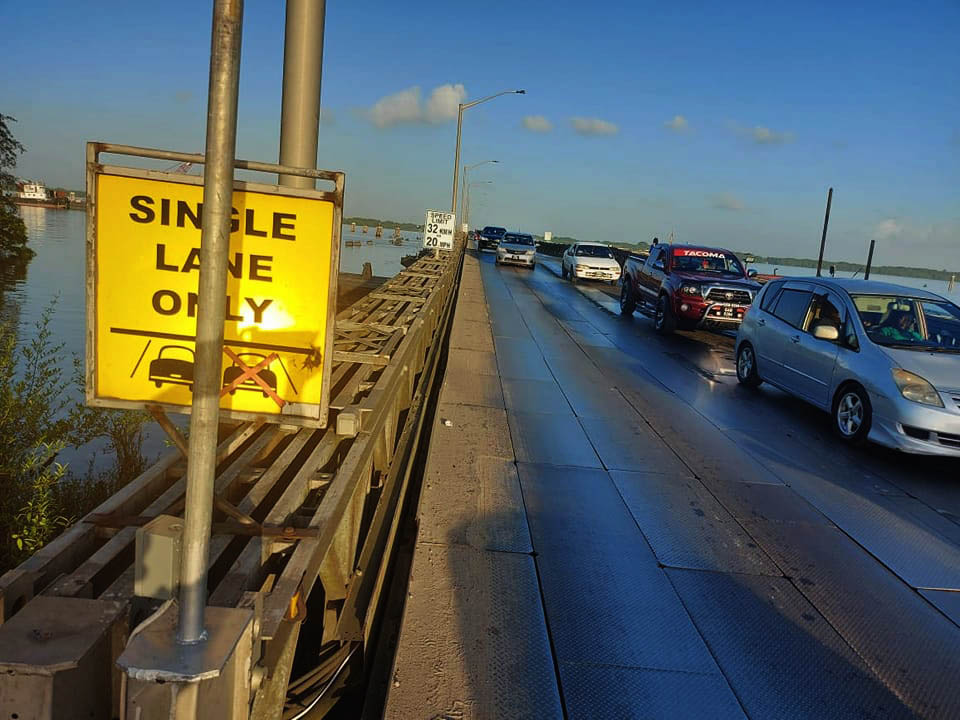The completion of major rehabilitation on the Demerara Habour Bridge now places the bridge company in a better position to replace the damaged span nine and realigning of the bridge, General Manager Wayne Watson recently said.
In a telephone interview, Watson said they have commenced their anchoring programme which will aid in repositioning the aged structure. He stated that their plan is to place 200 new anchoring blocks into the river to hold the bridge in place during falling tides. The General Manager also said these are preparatory works in anticipation of replacing span nine. He explained that they have submitted a work plan to the government for approval, and once they receive the green light they will announce the date of the next lengthy closure.
The next closure is scheduled for some time in this month, March.
Once the realignment is completed, Watson said that they will be in a position to consider lifting the weight restrictions on the bridge. Currently, the bridge permits trucks up to 18,000 tonnes to traverse.
Meanwhile, he disclosed that they were able to complete all scheduled works ahead of time during the recent closure. The Demerara Harbour Bridge was reopened at around 1 am last Monday following its closure on Saturday night. Watson on Sunday night had said the major work on the bridge entailed changing two static rollers, a transom beam, six panels and the mechanism to secure the changes. Once the repairs began, however, they were faced with unforeseen challenges which led to a delay. Nevertheless, the work pressed on with input and manpower from InFab, the contracted company.
“What we encountered this morning [Sunday] whilst trying to remove the static ruler on the left side [was] the timeout panel. When it was hit by the vessel in October, it was tilted about 15 to 30 degrees… So when we tried to raise the structure to take out the static roller, we were focused above but also we realized that the security bolts, that secure the panel to the chair on the pontoon, those ports [were] severed. So, when we focused on raising the bridge upward, the bridge was literally rising from below,” Watson had further explained. This forced the team to return to the table and reengineer the work plan, incurring a three and a half hours deficit.
Watson explained that the work could not have been put off further as the tide conditions were favourable to execute it. “We had to get the ‘jack tide’ when the waters were calm and allowed for easy working conditions. Other tides would have affected the work because of the movement of the pontoon. And if you do that type of activity when the tide is either going north washing or falling or the rate at which we’re experiencing due to the recent dredging of the river, it would have caused difficulty. We have to work with a specific tide,” he said at the time.
The proposed work in March is also dependent on a similar tide situation.
The emergency repairs commenced just around 10 pm on Saturday, five hours ahead of the scheduled 24-hour closure. The repairs became critical after the Panama-registered oil tanker, MV Tradewind Passion crashed into the bridge; in October 7, around 2 am, the Trade-wind Passion, a Panaman-ian registered vessel, was navigating the channel to offload fuel at GuyOil’s Providence Terminal, when it crashed into the bridge, and rendered it inoperable for several days. The vessel was the fifth one to transit the channel, with the previous four experiencing no issues. The crash, believed to be the most serious collision in years on the 44-year-old structure, crumpled sections of the bridge.
At the time of the incident, the vessel was being piloted through the channel by one of Guyana’s five river pilots. Noting the unusual circumstances that led to the accident, the pilot was taken into custody by the Maritime Administration Depart-ment (MARAD) and handed over to the police for drug and alcohol testing. However, the results of those tests returned negative and according to MARAD, the vessel was fully manned at the time of the crash.





